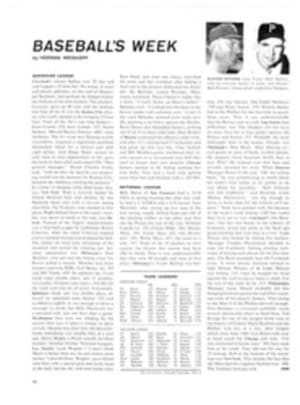
The tumorous trout
In most states the trout season is already open, and within the next few weeks anglers everywhere will have been on their favorite streams. Most of them will take their quota of fit, healthy fish; but before the seasons have closed this year some of the fishermen may take home trout suffering from cancer.
In the past three years rainbow trout afflicted with hepatoma, or primary cancer of the liver cells, have been discovered in fish hatcheries. Brook trout have turned up with milder but also potentially malignant tumors, or intestinal granuloma. The disease has taken hold in fish reared in hatcheries and released into streams and lakes in normal stocking procedures. The cause of cancer in these trout is not definitely known, but scientists suspect the hatchery diets.
For many years federal, state and private hatcheries reared brood trout on bits of raw beef, pork and mutton. While the fish were still fingerlings the fresh meat diet was not too expensive, but it began to make less dollar sense as the fish grew bigger and hungrier. Consequently, most hatcheries have now switched to manufactured feeds. These are compounded of such stuffs as dried animal meals, vegetable meals, vitamins and minerals; the fish have accepted the change and the hatcheries are convinced the feeds are every bit as wholesome as all-meat diets. At any rate, the trout have grown fatter faster at less cost.
But they have also begun to grow tumors. To find out why, the federal Fish and Wildlife Service called on Dr. Wilhelm C. Hueper of the National Cancer Institute. Hueper's past studies have concerned additives to food for human consumption and their possible carcinogenic (i.e., cancer-inducing) properties. In his new assignment, he analyzed several commercial fish feeds and found they contained some suspect additives. Then he and his associates obtained a group of young rainbow trout from the same egg supply. Half, in a federal aquarium, were fed sheep liver. They developed no signs of cancer. The other half, housed in a hatchery, were fed one of the commercial mixtures. Nearly all the hatchery rainbows later developed liver tumors. Other examinations were conducted over a period of three years at nine hatcheries across the U.S., and the consensus of both Hueper and the hatchery men was that the commercial feeds probably were causing cancer. Although Hueper emphasizes his evidence is only circumstantial, it is strong enough to have become the basis of a half-million-dollar lawsuit brought by one hatchery against a western feed manufacturer.
A spokesman for the Fish and Wildlife Service says that the feeds now in use by hatcheries have been "drastically modified," and that his agency is satisfied that there is no epidemic of fish cancer at present. But some questions remain unanswered. For one thing, neither Hueper nor anyone else is sure which constituents of the feeds might be cancer-inducing. One scientist studying the case suggests that chemical changes in the feed, overfeeding and even lubricants in the feed-grinding machinery may all play a role. A second problem, particularly for fishermen, is that no one can know how many cancerous trout have been released in stream-stocking programs, let alone how many have survived. Since hepatoma has been found in rainbows five years old, there could be plenty still around.
Where does that leave the fisherman who has caught a mess of trout? On the horns, unfortunately, of a rather prickly dilemma. There is no way he can detect the disease unless it is far enough along to cause pea-size white nodules on the liver or unusual abdominal swelling—or unless he takes the trout in for a posthumous histopathological examination. And while there is no evidence that a man can get cancer from eating an infected trout, there is also no evidence that he cannot. Dr. Herman Kraybill, of the National Institute of Health, says it is perfectly safe to eat any trout, so long as it has been gutted. Hueper, whose Cancer Institute is one of the divisions under the National Institute of Health's command, hopes the notion is correct, but is more cautious. This optimistic view "is not justified," he says, "because of the distinct lack of practical and scientific experience in such matters and especially because the causal agent is unknown. I do know that I wouldn't eat one that showed any evidence of a tumor."

